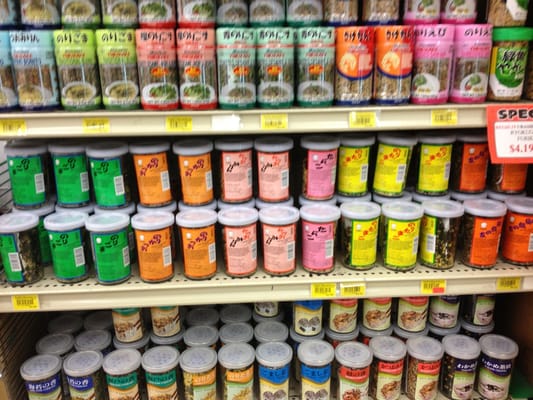If you've never had furikake before, it's one of those condiments that you won't remember how you lived without once you try it. You'll want to put it on everything--not just your congee, but your popcorn and noodles and fish dishes. You'll sneak it onto sandwiches and into salads--and because it's rich in vitamins A, B12 and C, not to mention iodine, iron and zinc, you'll feel virtuous while doing it.
This simple furikake is just one of countless possible variations on furikake; many versions include bits of dried fish, miso, sea salt, egg, preserved plum, or roasted rice. If you're not as excited about making your own as I am, you can buy all kinds of prepared furikake at many grocery stores that stock Japanese ingredients. Here's a neat photo from Yelp user Chad Y. of the furikake shelf at Pacific Mercantile Company, an Asian Market in Denver. Look at all those different furikakes!

Another benefit of this particular furikake is that it can help to tonify your Kidney qi, because it uses hei zhi ma (black sesame seeds) and nori, which is black in color and therefore tonifying to the kidneys.
 |
| Here's the kind of nori I buy. |
Nori goma furikake:
1/2 c black sesame seeds (hei zhi ma)
5 sheets nori
2 tbsp soy sauce (use gluten-free tamari instead if you need to keep this recipe gluten-free)
1 tbsp mirin
1/2 tsp chili flakes
Preheat oven to 320 degrees Fahrenheit.
Line a baking sheet with a silicone non-stick liner or parchment paper.
In a medium-sized bowl, mix the soy sauce, mirin, and chili flakes.
Tear or scissor the nori into small pieces. They don't have to be super-small; you'll crumble them smaller later. Put them in a small bowl and toss them with the soy sauce mixture.
Spread the nori mixture on the baking sheet and bake for 10 to 25 minutes.
 |
| Should look wet and clumpy like this. |
Check after 10 minutes and every 5 minutes thereafter. Pull the nori out of the oven when it feels dry and crisp to the touch.
 |
| Dry and crisp now, not wet and clumpy |
While the nori is baking, prepare your sesame seeds this way.
When the nori is cool enough to handle, crumble it into teeny-tiny pieces. You're going for sprinkle-size pieces, about the same size as the chili flakes. You can also use small kitchen shears for this, but I think crumbling it in your hands is more fun. Mix with the roasted sesame seeds.
Stored at room temperature in an airtight jar, this stuff will keep indefinitely. Sprinkle it on your congee, then try sprinkling it on everything else. It's seriously heaven on popcorn.
This is a pretty subjective recipe, by which I mean your preferences for salty, pungent and spicy might be very different from mine. Play with the ratio of soy sauce, mirin and chili flakes each time you make this recipe till it tastes exactly right to you.












